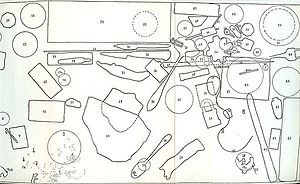
In our discussion of rhizomes and rhizomatic properties, I was reminded of a book by Daniel Spoerri, An Anecdoted Topography of Chance (1962, 1966). Spoerri, a participant in the Fluxus movement, embarks upon a literary experiment in which he catalogues everything that happens to be lying on a blue table in Room 13 of the Hotel Carcassone at 24 Rue Mouffetard in Paris, where he was staying. It’s a “topography based on chance and the disorder that I snared on October 17, 1961 at 3:47 p.m.” (xv-xvi). The book’s front endpaper and inside jacket include a rudimentary hand-drawn map, which delineates the shape of each object. “Each outlined object is numbered, and the game I suggest is to choose a shape on the map and look up the corresponding numbered paragraph in the text” (xvi). The anecdotes consist of a history of the object and how it came into the author’s possession or vicinity. Many of these anecdotes spin off into other contexts that can only be related to the objects via associations Spoerri makes in his memory or imagination.
The publisher’s statement warns that the Table of Contents cannot be used as a key to the map. In other words, the reader must use the map to find her way around the text, or invent her own game for reading (xiii). The publisher also announces that supplements to the original (English) text will be issued “at irrregular intervals” and invites readers not only to subscribe, but to “send in contributions to these supplements in the form of further annotations and comments on the one hundred and one articles in this text…particularly…relating to the IV, V, XI, and XIX arrondisements of Paris, in which much of the action in this book takes place.” Thus, the reader will become a participant in sketching out a spatially- and temporally-layered topography based on his own knowledge, associations, and experiences.
Emmet Williams, translator of the English edition, has also included his own annotations and “anecdotations” of the text, which pose questions about the objects Spoerri describes, refer to his own tangential experiences loosely related to the objects, or comment on Spoerri himself. Spoerri adds additional notes to his anecdotes as well. The book is a playful illustration of what something like Deleuze & Guattari’s connected rhizomatic dimensions might look like, as much as it would be possible to capture such things in the printed word.
One of the more straightforward, contained entries, on page 28:
No. 14
Package of Twining’s Chinese Tea
which I bought for a change
of aroma, although I still
have some Orange Pekoe left.
I wanted smoked tea and
they sold me this package
pretending it was, which it
wasn’t.
On page 79, Spoerri extends the conceptual territory of this anecdote (and includes a cross-reference):
(f) Two candle butts
one of which was squeezed
near the wick when the wax
was still warm. I remember
neither their use nor their
origin, but since I often blow
out fuses by plugging on all
kinds of apparatuses and art
objects, there is nothing as-
tonishing about their pres-
ence in my room. In the crypt
at Vezelay, the candles the
pilgrims light in honor of the
VIRGIN plop down onto a
sheet of iron where the wax
makes a very lovely picture,
as HAINS pointed out to me
on our trip to Nice (No. 31).


